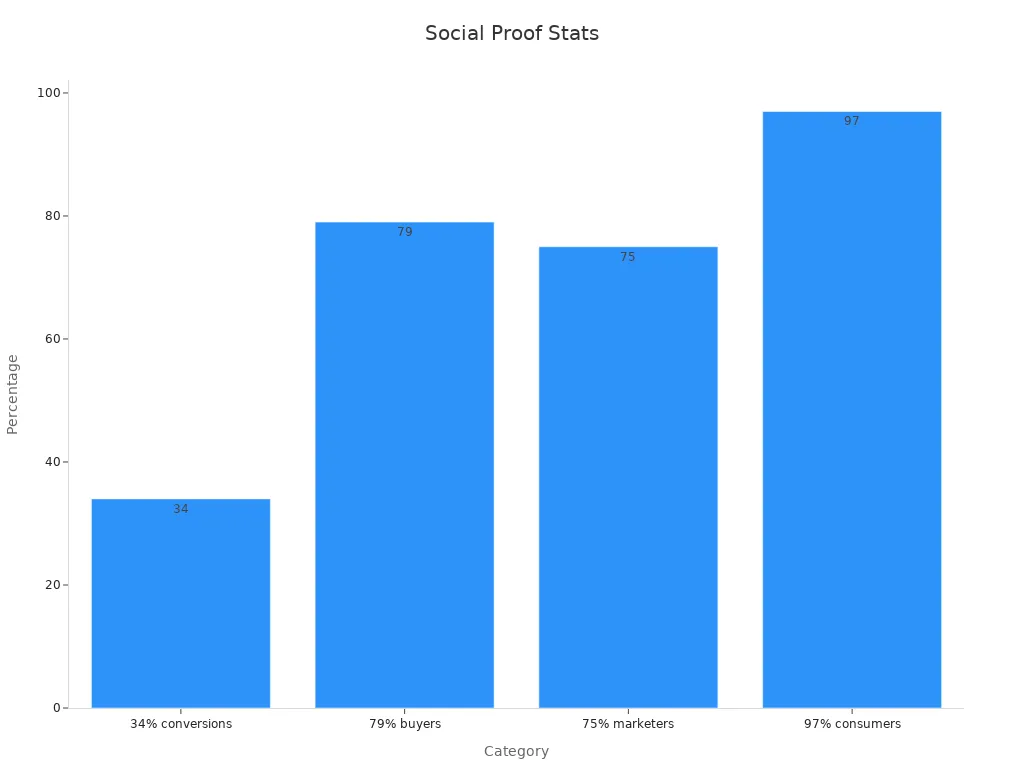10 Proven Tips to Write High-Converting Product Descriptions

In online shopping, high-converting product descriptions are more than just words. They act like your sales pitch to customers. Did you know 87% of shoppers think detailed product info is key? That’s because good descriptions do more than explain—they persuade. They build trust, calm worries, and make buyers feel sure about clicking “Buy Now.”
Strong high-converting product descriptions can even double your sales. They do this by connecting with feelings and solving problems. Every word you pick is important. Whether you sell mugs or t-shirts, clear and fun descriptions turn lookers into buyers. Want to know how to do this? Let’s get started.
Understand Your Target Audience
Knowing your target audience is key to writing great product descriptions. When you understand them, it’s easier to write messages that catch their eye. Let’s explore how to do this step by step.
Research customer demographics and preferences
Start by figuring out who your ideal customer is. Ask questions like:
How old are they?
Are they male or female?
Where do they live?
How much money do they make?
What job do they have?
These details help you learn what your audience wants and how they decide. For example, people buying luxury goods may care about quality and uniqueness. Budget shoppers might focus more on saving money and usefulness.
Use surveys, interviews, or online tools to gather this information. Look at competitors to see trends in your market. Combine all this data to create profiles of your customers. These profiles will guide your marketing choices.
Tip: Numbers are helpful, but talking to customers gives deeper insights into their habits and likes.
Address customer pain points and desires
After learning about your audience, focus on their needs and struggles. Do they want convenience? Are they searching for eco-friendly products? Show in your descriptions that you understand their challenges.
For instance, if your product saves time, explain how it makes life easier. If it’s a gift, describe how it can brighten someone’s day. Use examples to show how your product fits into their daily lives.
Check metrics like customer loyalty and drop-off rates to see what works. If customers return often, you’re meeting their needs. If they leave, it’s time to adjust your strategy.
By focusing on what your audience wants, you’ll write descriptions that feel personal and convincing.
Maintain a Consistent Voice and Tone
Your brand’s voice and tone show its personality. They help customers understand who you are and what you value. Keeping them steady in all product descriptions builds trust. It also makes your brand easy to remember. Let’s explore how to do this.
Match tone with your brand’s identity
Your tone should fit your brand’s style. Are you bold and daring, or kind and welcoming? Think about how you want customers to feel about your brand. A steady tone helps create that emotional bond.
Here are examples of brands using clear tones:
Brand Example | How It Helps |
|---|---|
Cosmetics Brand | Fun emails boost open rates and clicks. |
Travel Company | Friendly chatbots improve user experience and brand image. |
Outdoor Apparel Brand | Adventurous stories build emotional connections and encourage sharing. |
Hospitality Brand | Warm messages lead to repeat bookings and good reviews. |
Wendy's | Witty social media creates loyal fans and happier customers. |
Consistency isn’t just about sounding nice—it gets results.
Tip: Before writing, ask yourself: “Does this sound like my brand?” If not, adjust it until it does.
Pick professional, casual, or playful tones
The tone you choose depends on your audience and message. Professional tones work well for serious fields like healthcare or finance. Casual tones make brands feel friendly and easy to approach. Playful tones add fun but may not fit every audience.
Here’s how tones affect brands:
Playful tones can surprise people but may seem unprofessional in serious industries.
Casual tones make brands feel relatable and trustworthy.
Humor can make you stand out, but it’s risky. If customers don’t laugh, it could hurt your brand.
Emotional needs matter too. In stressful places like hospitals, a kind tone can calm people.
Most brands find casual tones work best. But knowing your audience is key. What makes them feel at ease? What tone fits their needs? Answering these questions helps you find the right balance.
Note: Test different tones to see what works for your audience. A/B testing can show which tone fits your brand best.
Highlight Product Benefits Over Features
When writing product descriptions, focus on benefits, not features. Features explain what a product does. Benefits show how it helps your life. This approach connects better with customers and boosts sales.
Show how the product solves problems
Think about the problems your customers face. Your product should be the answer they need. Instead of listing details, explain how it makes life easier or fixes issues.
Why benefits work:
Non-tech buyers prefer simple solutions over complicated terms.
Half of B2B searches happen on phones, so clear benefits are key.
Marriott Hotels promoted rewards by focusing on free stays and views, not program rules.
By showing how your product solves problems, you’ll write descriptions that grab attention and build trust.
Use everyday examples to explain benefits
Everyday examples make your product’s benefits easy to understand. They help customers picture how your product fits their life. Instead of saying, “This mug keeps drinks hot,” say, “Imagine your coffee staying warm during long meetings.”
Here are ways to show benefits:
Strategy | What It Does |
|---|---|
Show How It Works | Use pictures or videos to explain your product. |
Let People Try It | Give customers a chance to test your product. |
Share Customer Stories | Use real reviews to prove your product works. |
Use Case Studies | Show examples of how your product solved problems. |
Make Benefit Videos | Focus on results your product delivers. |
Leverage Storytelling in Product Descriptions

Share the story behind the product
Every product has a unique story to tell. Sharing this story makes your descriptions stand out. People enjoy learning how a product was made or what inspired it. These details make your product feel special and meaningful.
Why does storytelling work? Stories are easy to remember and keep people interested. They help brands share product details in a way that feels important. When you tell your product’s story, you’re inviting customers to join its journey, not just buy it.
Create an emotional connection with the audience
Feelings often guide decisions. Descriptions that touch emotions are more convincing. Customers want more than features—they want solutions and experiences. Emotional connections make your product feel personal and relatable.
Think about how your product improves someone’s life. If you sell a cozy blanket, don’t just list its size or material. Instead, describe it like this: “Snuggle up with this blanket on cold nights and feel at home. It’s perfect for movie marathons or relaxing with a book.” This helps customers imagine using your product and feeling happy.
Emotions can shape choices. Show how your product solves problems or brings joy. This makes people more likely to buy. Storytelling adds a human touch to your brand. It turns your product into something meaningful, like a source of comfort and happiness.
Tip: Use everyday situations to show how your product fits into life. This makes your descriptions more relatable and touching.
Optimize Product Descriptions for SEO
SEO helps your products get noticed online. But how can you use it to make your descriptions stand out? Let’s break it into two easy steps.
Use keywords naturally
Keywords help search engines find your products. Use them naturally to make your page clear and attract the right audience.
Here’s how:
Add keywords in your description, but don’t overuse them. For example, instead of saying, “This SEO-friendly mug is perfect for SEO fans,” try, “This mug is great for anyone who loves improving their workspace.”
Pick keywords that match what people search for.
Don’t cram keywords into sentences. Search engines dislike pages with too many keywords. Write like you’re talking to a friend.
Using keywords naturally makes your descriptions easier to read. It also helps attract the right customers and keeps them interested.
Write meta descriptions that grab clicks
Meta descriptions are short summaries that show up in search results. They act like tiny ads for your product. A good meta description can bring more visitors to your site.
Here’s how to write one:
Keep it short—around 160 characters. This makes sure it fits in search results.
Add keywords to improve your ranking and make it searchable.
Include a call to action that invites clicks. For example, “Shop now for warm winter scarves with free shipping!”
Each product page needs its own unique meta description. Pages with repeated descriptions get fewer clicks and lower rankings. Custom descriptions that match what users want can boost clicks by up to 40%.
Writing meta descriptions that meet customer needs doesn’t just help SEO. It also makes it easier for people to find and choose your products.
Incorporate Social Proof

Social proof helps build trust and increase sales. People believe what others say about your product more than what you say. Adding reviews, testimonials, and endorsements makes your product descriptions more convincing and relatable.
Include customer reviews and testimonials
Customer reviews are super valuable for your product pages. They show buyers that others have used and liked your product. Did you know 97% of shoppers read reviews before buying? That’s almost everyone! Reviews make your product seem reliable and trustworthy.
Why do reviews work?
79% of people trust reviews like personal advice.
Products with five reviews are 270% more likely to sell.
Reviews can boost sales by 18% on average.
You can show reviews in different ways. Add star ratings, highlight great testimonials, or use video reviews. Fun fact: 79% of buyers watch video testimonials to learn about products. Videos build trust fast and make your product stand out.

Tip: Ask happy customers to leave reviews. A follow-up email works great.
Highlight endorsements or awards
Awards and endorsements make your product more trustworthy. If experts or organizations have praised your product, share it!
Awards show that professionals respect your product, not just customers. This can help unsure buyers feel confident. Even a small badge or logo from a trusted group can make a big impact.
Note: No awards yet? Focus on customer reviews or user content. These work just as well to build trust.
Using social proof isn’t just about selling—it’s about building a strong reputation. When people see others recommending your product, they’ll feel more confident clicking “Buy Now.”
Make Descriptions Easy to Skim
When shopping online, people don’t read everything. They skim for key details. That’s why it’s important to make your product descriptions easy to skim. This helps customers quickly see what you’re offering without feeling lost. Here are two simple ways to do this.
Use bullet points to show main features
Bullet points are great for showing important features. They make descriptions shorter and easier to read. Instead of writing a long paragraph, list key points like:
Safe for dishwashers
Made without BPA
Comes with a lifetime guarantee
Why are bullet points helpful?
They make reading faster for busy shoppers.
They organize features and benefits clearly.
They highlight what makes your product special.
Think of bullet points as a way to show the best parts of your product. They’re simple and help grab attention.
Add subheadings and short paragraphs
Big blocks of text can scare readers away. Using subheadings and short paragraphs makes your content look better. Subheadings guide readers and organize your description. Short paragraphs are easier to read, especially on phones.
Here’s why this works:
Subheadings help readers find what they need faster.
Short paragraphs (2-3 sentences) are less overwhelming.
Subheadings keep readers interested, even if they’re skimming.
Check out this table to see why scannable content is useful:
Benefit | Why It Helps |
|---|---|
Better Understanding | Scannable content helps readers remember details. |
Highlights Important Info | Key details stand out and are easier to recall. |
Clear Layout | Makes it easier to follow the information. |
Less Overwhelming | Focuses on what matters most without too much text. |
By breaking up text and using subheadings, your descriptions become more appealing and easier to read. Customers will appreciate it—and your sales might improve too.
Tip: Always check how your descriptions look on a phone to make sure they’re easy to skim.
Appeal to Gifting Potential
Show your product as a meaningful gift
Think about how a special gift can brighten someone’s day. Showing your product as a great gift can really help sales. People enjoy giving items that feel personal and thoughtful. Mentioning this in your descriptions can attract shoppers looking for unique presents.
The U.S. gifting market is growing fast. More people now want personalized gifts for all kinds of occasions. It’s not just about holidays anymore. Birthdays, anniversaries, and even “just because” moments are popular too. When you explain how your product fits these events, you appeal to gift-givers searching for the perfect choice.
For instance, if you sell custom mugs, describe them as ideal for coffee lovers. Say something like, “Give a mug as unique as your loved one.” This makes buyers feel connected and helps your product stand out.
Tip: Use words like “special,” “unique,” or “personalized” in your descriptions. These words attract shoppers looking for heartfelt gifts.
Tie your product to events or seasons
Timing matters when selling gifts. Mentioning specific events or seasons helps customers imagine when they’d buy your product. Whether it’s Christmas, Mother’s Day, or a birthday, linking your product to these times makes it more appealing.
During holidays, shoppers look for deals and presents. This time can make up 40% of yearly sales for many businesses. If you sell candles, describe them as “perfect for stockings” or “a cozy winter gift.”
Businesses that focus on seasonal marketing often see big gains. Some increase revenue by 15% during holidays. Others boost customer engagement by 25% with seasonal campaigns. These results show how linking your product to the right moment can pay off.
Note: Don’t forget smaller events like housewarmings or graduations. These are also great chances to promote your product as a thoughtful gift.
Tailor Descriptions for Print-on-Demand Products
Show off customization options
Print-on-demand products are all about customization. People love making items that match their style or needs. Instead of saying, “This mug is customizable,” try, “Add your favorite quote or date to make a mug that’s truly yours.”
Give customers ideas to spark creativity. For example, “Design a t-shirt with your team’s logo for game day” or “Create a tote bag perfect for your next beach trip.” These examples help them picture how they’ll use your product, making it more exciting.
Tip: Use clear, colorful words to describe the finished product. This helps customers imagine owning it, which can increase their interest.
Focus on the special touch of made-to-order items
Made-to-order products feel more personal than mass-produced ones. Highlight this by talking about the care and attention in each piece. For example, say, “Every item is made just for you, reflecting your unique style.”
People like products that feel one-of-a-kind. Mention how these items reduce waste or support small businesses. These points make your product stand out and attract eco-friendly shoppers.
Note: Check customer reviews often to see what they love most. Use this feedback to improve your descriptions and make them even better.
Explain how Yoycol makes things easy
Yoycol simplifies the print-on-demand process. Their platform lets you design, customize, and sell without worrying about inventory or shipping. This allows you to focus on creating designs your audience will love.
Tip: Watch metrics like conversion rates to see how your descriptions perform. Update them based on customer feedback to keep them effective.
Test and Improve Your Descriptions
Writing product descriptions isn’t something you do just once. To connect with your audience and increase sales, you need to update and improve them often. Here are two easy ways to make sure your descriptions work well.
Watch metrics like conversion rates
Metrics are like a guide for your marketing efforts. Numbers like conversion rates, click-through rates (CTR), and engagement rates show how your descriptions perform. For example, if you want to raise CTR by 5%, tracking these numbers helps you see progress.
Checking these metrics often shows what’s working and what isn’t. Are people clicking but not buying? Maybe your descriptions need to focus on benefits. Are visitors leaving quickly? Try shorter, easier-to-read descriptions. Setting clear goals helps you find areas to improve and make your pages better.
Tip: Use tools like Google Analytics or Shopify analytics to track these numbers. They give helpful insights to improve your strategy.
Test two versions to see what works better
A/B testing helps you learn what your audience likes. It’s easy: make two versions of a description and see which one does better. You can test things like headlines, tone, or bullet point placement.
Note: Start with one change at a time. This makes it easier to see what’s improving results.
By tracking metrics and testing different versions, you’ll learn what your audience prefers. These tips will help you write descriptions that grab attention and turn visitors into buyers.
Writing product descriptions that sell well can change your business. These descriptions do more than explain—they connect with buyers, fix their problems, and boost sales. By using these tips, you can write descriptions that your customers will love and that stand out from the competition.
Here’s a quick summary of what you’ve learned:
Key Points | Explanation |
|---|---|
Writing to Persuade | Make descriptions that connect with buyers and show what makes your product special. |
Power of Stories | Add stories and customer reviews to make descriptions stronger. |
Better SEO | Use keywords to help people find your products online. |
Boosting Sales | Learn how descriptions can help sell custom-made products. |
Yoycol helps make things easier for you. Their platform handles the hard parts of print-on-demand, so you can focus on designing great products. With Yoycol, you can turn your ideas into custom items your customers will enjoy.
Tip: Try different ways of writing your descriptions. Test them out and improve based on what your customers like best.

